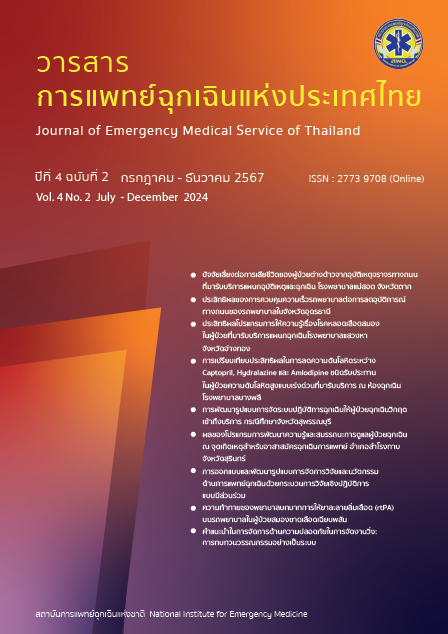A model development of research and innovation management for Emergency Medical Service
Keywords:
research management, evaluation, research and innovation, emergency medicineAbstract
This research aimed to develope a model for managing emergency medical research and innovation through partic ipatory action research; and to monitor and evaluate the efficiency, outputs, and outcomes of each project managed under this model. The development process of this management model was conducted in three phases, applying the concepts of Kemmis & McTaggart in four key steps: Planning, Action, Observation, and Reflection. The effectiveness of the research management model was monitored and evaluated by collecting both quantitative and qualitative data from target groups based on the CIPP Model, which is a project evaluation approach used to guide decision-making at various stages of the project — Context, Input, Process, and Product. Quantitative data were analyzed using descriptive statistics, while qualitative data were analyzed through content analysis. The research was conducted from October 2022 to September 2023. Through a literature review and collaboration with research management agencies, as well as within the National Science, Research, and Innovation System (NSRI), it was found that all agencies manage research in 3 stages; including (1) upstream level, (2) Mid-steam level, and (3) downstream level. In recent years, research management has focused on utilizing research outputs. This study co-designed and developed a research and innovation management model for emergency medicine, aiming to push research results toward policy utilization and emergency medical system development at the local level. It considered 14 factors for effective management, covering 12 main activities across the three stages, through eight management mechanisms, methods, and tools. This was conducted under a comprehensive, inclusive, and equitable emergency medical system development plan for the fiscal year 2023, driven by an intelligent organization. The evaluation revealed that, overall, most researchers under stood the management model, policies, and research strategies well. However, there were some problems and obstacles that need improvement in the next year. These included limited participation in setting research directions, issues with regulations, guidelines, conditions, and research expense reimbursement rates, as well as insufficient technology support and unclear pro cedures. In mid-term research management, there were issues with operational support systems for document handling and progress reporting, which were not efficient enough. Problems also arose with the bureaucracy, such as delays in expense reimbursement, contracts, and project approval processes. In the final phase, issues were related to the clarity of how research results would be disseminated and utilized. The output monitoring showed that most of the research management goals aligned with the targets set by the Thailand Science Research and Innovation (TSRI). Policy management was coordinated with the Health Systems Research Institute (HSRI) to open a research plan for the development of the emergency medical system. However, to enhance the efficiency and application of research knowledge, it is essential to continuously strengthen research management across all three phases, focusing on key activities at each stage, especially on fostering participation and identi fying tools and methods that enable researchers to conduct their work efficiently. Additionally, systematic monitoring of the research’s efficiency, outputs, and outcomes is necessary.
References
สถาบันการแพทย์ฉุกเฉินแห่งชาติ. พระราชบัญญัติการแพทย์ฉุกเฉิน พ.ศ. 2551
สถาบันการแพทย์ฉุกเฉินแห่งชาติ. ผลงานวิชาการ: รายงานฉบับสมบูรณ์และ EMS Brief เกี่ยวกับการแพทย์ฉุกเฉิน ตั้งแต่ปี 2555 – 2565 [อินเตอร์เน็ต]. 2565 [สืบค้นเมื่อ 13 ก.พ. 2561]. แหล่งข้อมูล: https://www.niems.go.th/1/SubWebsite/?id=1678
สถาบันการแพทย์ฉุกเฉินแห่งชาติ. เปิดผลงานเด่น สู่การยกระดับการแพทย์ฉุกเฉินไทย. อดีต ปัจจุบัน สู่อนาคตงานวิจัยด้านการแพทย์ฉุกเฉิน หน้า 28-33, 2562.
เกรียงศักดิ์ พราวศรี. การจัดการระบบสารสนเทศในการบริหารโดยใช้โรงเรียนเป็นฐานเพื่อการประกันคุณภาพการศึกษา.กรุงเทพฯ : บุ๊คพอยท์. 2544.
เสมอ ถาน้อย. การบริหารงานวิจัยสไตล์ มน. [อินเตอร์เน็ต]. 2550 [สืบค้นเมื่อ 14 ต.ค. 2561]. แหล่งข้อมูล:
https://www.gotoknow.org/posts/136263
เยาวดี รางชัยกุล วิบูลย์ศรี. การประเมินโครงการแนวคิดและการปฏิบัติ. กรุงเทพฯ : จุฬาลงกรณ์ มหาวิทยาลัย
สมพร อิศวิลานนท์. การจัดการงานวิจัยสู่ผลลัพธ์และผลกระทบ: แนวคิดและกรณีศึกษา. สถาบันคลังสมองของชาติ [อินเตอร์เน็ต]. 2561 [สืบค้นเมื่อ 07 ก.ย. 2565]. แหล่งข้อมูล: http://www.knit.or.th/web/wp-content/uploads/2018/06/Managementofresearchintooutcomesandimpacts.pdf
สำนักงานคณะกรรมการส่งเสริมวิทยาศาสตร์ วิจัยและนวัตกรรม (สกสว.). คู่มือการจัดทำคำของบประมาณและการบริหารจัดการงบปประมาณเพื่อสนับสนุนงานมูลฐานตามพันธกิจของหน่วยรับงบประมาณ (fundamental fund; FF) ประจำปีงบประมาณ พ.ศ. 2567. เอกสารอัดสำเนา. 2566.
ปัทมาวดี โพชนุกูล, ประภาพร ขอไพบูลย์, ชนาธิป ผาริโน. การวิจัยเชิงยุทธศาสตร์. หนังสือชุดการบริหารจัดการงานวิจัย สกว.เล่มที่ 1 นวัตกรรมการบริหารจัดการงานวิจัย.บริษัทชิโน พับลิชชิ่ง แอนท์ แพคเกจจิ้ง จำกัด.กรุงเทพ.: สำนักงานกองทุนสนับสนุนการวิจัย (สกว.), 2561.
จันทรวิภา ธนะโสภณ. นวัตกรรมงานวิจัยแบบมุ่งเป้า. หนังสือชุดการบริหารจัดการงานวิจัย สกว.เล่มที่ 1 นวัตกรรมการบริหารจัดการงานวิจัย.บริษัทชิโน พับลิชชิ่ง แอนท์ แพคเกจจิ้ง จำกัด.กรงเทพ.: สำนักงานกองทุนสนับสนุนการวิจัย (สกว.), 2561.
มนตรี สังข์ทอง, ประภาส กลับนวล, ศศินันท์ ศาสตร์สาระ, อามีนะห์ ไชยธารี, พรพิมล เชียรพิมาย, สมพร วงศ์ศักดิ์. การประเมินระบบและกลไกการบริหารจัดการงานวิจัยของหน่วยวิจัยนวัตกรรมเพื่อสังคมและชุมชน (ระยะที่ 3). วารสารวิจัยระบบสาธารณสุข. 2562; 14(2):81-101.
ฉัตรนภา พรหมมา. รูปแบบการประเมินเสริมพลังการบริหารจัดการงานวิจัยและพันธกิจสัมพันธ์มหาวิทยาลัยราชภัฏอุตรดิตถ์กับชุมชนท้องถิ่น. วารสารวิชาการมหาวิทยาลัยราชภัฏอุตรดิตถ์. 2561; 13(2):1-12.
อริศาพัชร จักรบุตร. แนวทางการเพิ่มประสิทธิภาพการบริหารจัดการงานวิจัย ของมหาวิทยาลัยราชภัฏศรีสะเกษ. วารสารงานวิจัยและพัฒนา มหาวิทยาลัยราชภัฏศรีษะเกษ. 2565; 9(1):1-17.
นที เชี่ยวสุวรรณ, นันทรัตน์ เจริญกุล. แนวทางการบริหารงานวิจัยตามนโยบายของจุฬาลงกรณ์มหาวิทยาลัย. OJED. 2016;11(2):107-21.
ดวงเดือน ภูตยานันท์, ธีรวุฒิ บุณยโสภณ, วิเชียร เกตุสิงห์, ไพโรจน์ สถิรยากร. การพัฒนารูปแบบการบริหารงานวิจัยของมหาวิทยาลัย. วารสาริชาการพระเจ้าเกล้าพระนครเหนือ. 2554;21(267-376).
อริศาพัชร จักรบุตร. แนวทางการเพิ่มประสิทธิภาพการบริหารจัดการงานวิจัย ของมหาวิทยาลัยราชภัฏศรีสะเกษ. วารสารงานวิจัยและพัฒนา มหาวิทยาลัยราชภัฏศรีษะเกษ. 2565; 9(1):1-17.
วิภาพร นิธิปรีชานนท์, ประเสริฐ อินทร์รักษ์. แนวปฏิบัติที่ดีในการบริหารงานวิจัยของสำนักงานคณะกรรมการการศึกษาขั้นพื้นฐาน. วารสารการบริหารการศึกษา มหาวิทยาลัยศิลปากร. 2554;2(1):56-69.
วนิดา มงคลสินธุ์, จิตติรัตน์ แสงเลิศอุทัย, โยธิน ศรีโสภา. การพัฒนาตัวบ่งชี้การบริหารงานวิจัยการบริหารงานวิจัย มหาวิทยาลัยนวมินทราธิราช. วารสารพัฒนาและวิจัยหลักสูตร. 2561; 8(2):101-15.
ชนะวิทย์ อนุสุเรนทร์, สุวรรณี แสงมหาชัย. ผลสัมฤทธิ์ของการบริหารงานวิจัยของมหาวิทยาลัยวิจัยในประเทศไทย. Humanities & Social Sciences. 2562;36(2):126-62.
พิชิต ฤทธิ์จรูญ. การบริหารจัดการโครงการวิจัยให้สัมฤทธิ์ผล. วารสารวิชาการศรีปทุม ชลบุรี. 2563; 17(1):179-89.
กรมควบคุมโรค กระทรวงสาธารณสุข. หลักเกณฑ์และกรอบอัตราค่าใช้จ่ายโครงการวิจัย กรมควบคุมโรค. [อินเตอร์เน็ต]. 2562 [สืบค้นเมื่อ 15 ก.ย. 2566]. แหล่งข้อมูล: https://ddc.moph.go.th/uploads/files/3197120230210082426.pdf
กรมอนามัย กระทรวงสาธารณสุข.คู่มือหลักเกณฑ์การเบิกค่าใช้จ่ายในการศึกษาวิจัย.[อินเตอร์เน็ต]. 2560 [สืบค้นเมื่อ 15 ก.ย. 2566]. แหล่งข้อมูล: https://finance.anamai.moph.go.th/th/research-guide/download?id=104227&mid=30798&mkey=m_document&lang=th&did=31772
Downloads
Published
How to Cite
Issue
Section
License
Copyright (c) 2024 Journal of Emergency Medical Services of Thailand

This work is licensed under a Creative Commons Attribution-NonCommercial-NoDerivatives 4.0 International License.






